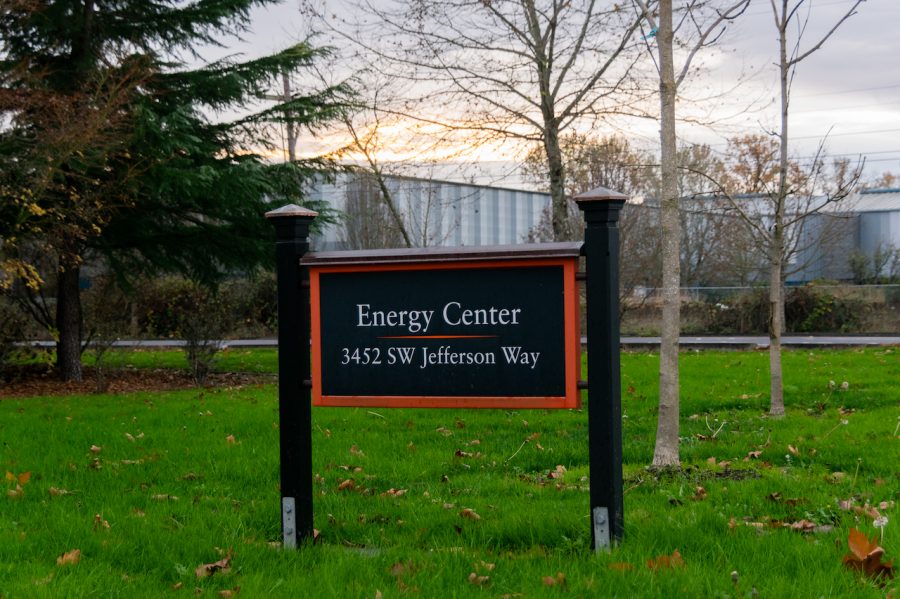COP26 restates efforts to limit global warming; Corvallis, OSU aim to reduce carbon footprint
The Oregon State University Energy Center, pictured on Nov. 23. The Energy Center has been an important part of reducing the university’s carbon footprint by providing efficient heating and electricity for campus.
November 29, 2021
Correction: This story originally incorrectly stated the Corvallis Home Energy Score Program received $58,000 from the Corvallis Climate Action Advisory Board. The correct information is the Corvallis Climate Action Revolving Loan Program received $58,000 from the CAAB fund. The Barometer regrets this error.
As the 26th annual United Nations Climate Change Conference of the Parties, or COP26, wrapped up on Nov. 13, Corvallis policymakers and Oregon State University officials are making strides to limit carbon emissions.
“I, personally, was hopeful that more progress would have been made at COP26,” said Shelly Signs, the director of university events and co-chair of the Carbon Commitment Committee at OSU.
At COP26, nations agreed that they would work toward maintaining the goal set by the Paris Agreement, a legally binding international treaty that aims to limit global warming to 1.5˚C. However, many countries failed to denounce the use of coal power and did not mention any significant financial allocation toward climate change initiatives.
“As a person deeply concerned by the climate crisis, I would like to see as much action taken as possible, at the earliest possible date,” said Dr. Keith Jayawickrama, a professor in the College of Forestry and co-chair on the Carbon Commitment Committee.
According to Jayawickrama, people run on a spectrum from the individual to the global, on climate action.
For example, Jayawickrama said if an individual decides to ride a bike instead of driving to work, that is a decision they make on their own, generally without needing others to buy in. There would be 100% emissions reductions on that one trip, said Jayawickrama, but it would be a very small part of the planet’s emissions.
“At the other extreme, getting 195 nations to agree and follow through on any emission reduction action—COP26—is very, very hard, but its impact is potentially huge compared to that one individual riding a bike on one day,” Jayawickrama said.
At an international level, progress toward carbon neutrality is slow, but what sort of strategies to reduce carbon emissions are happening at the local level?
The Corvallis City Council has been compiling a list of strategies to reduce the city’s carbon footprint, and in 2016, they drafted the Corvallis Climate Action Plan to turn these strategies into actions.
Current initiatives in the CCAP are the Climate Action Revolving Loan Program, Corvallis Home Energy Score Program and Electric Bicycle Instant Rebate Program.
The Climate Action Revolving Loan Program, which received $58,000 from the CAAB is designed to assist non-profit, cooperative and governmental education institutions in their efforts in shifting toward more sustainable energy sources.
“The Climate Action Advisory Board of Corvallis has allocated $100,000 toward climate-related projects and more than half of that money went to the revolving loan program,” said Jerry Sorte, economic development supervisor of the City of Corvallis.
The Corvallis Home Energy Score Program is a policy that would require an assessment of on-site home energy efficiency prior to listing a home for sale, aiming to educate homeowners about the future energy costs of their home and encourage them to implement energy-saving improvements.
“This is the primary project that the Climate Board has been working on since reconvening after the pandemic,” Sorte said.
According to Sorte, the CAAB resumed meeting on May 26, 2021, after having not met since Feb. 27, 2020.
The Electric Bicycle Instant Rebate program, funded by grants from Pacific Power and the Oregon Clean Fuels Program, allows for low-income Benton County residents to apply for a rebate of up to $1,200 with the purchase of an electric bike. This is meant to encourage alternative modes of transportation that don’t emit fossil fuels.
According to Sorte, one strategy to implement the CCAP has been to help fund energy-saving improvements to the homes of low-income individuals, through granting $30,000 to the Community Services Consortium in Corvallis.
Under OSU’s path to carbon neutrality, the university plans to allocate over $2 million per year to enhance green energy at OSU. Direct actions they plan to take to reduce carbon emissions include:
1) enhancing energy efficiency in the form of heating, cooling and lighting in OSU buildings,
2) reducing campus-wide water and energy use,
3) upgrading transportation services and land use planning, and
4) investing in solar equipment.
The plan will become official fairly soon, according to Jayawickrama, and he said there is still an opportunity for students, faculty and staff to give their input on what they’d like to see OSU do to lower carbon emissions, especially to Brandon Trelstad, sustainability officer of OSU’s Sustainability Office.
A list of energy efficiency programs can help OSU community members reduce their carbon footprint. According to Kathryn Duvall, economic development specialist for the City of Corvallis, this list was created by a group of OSU students who were interested in doing more to combat climate change. There are more than 20 programs listed that work to reduce greenhouse gas emissions.
“We will only reduce carbon emissions if individuals, schools, organizations, businesses, faith groups, civic groups, cities, states and nations all make it a priority and give their support,” Jayawickrama said.




















































































![Newspaper clipping from February 25, 1970 in the Daily Barometer showing an article written by Bob Allen, past Barometer Editor. This article was written to spotlight both the student body’s lack of participation with student government at the time in conjunction with their class representatives response. [It’s important to note ASOSU was not structured identically to today’s standards, likely having a president on behalf of each class work together as one entity as opposed to one president representing all classes.]](https://dailybaro.orangemedianetwork.com/wp-content/uploads/2025/03/Screenshot-2025-03-12-1.00.42-PM-e1741811160853.png)























